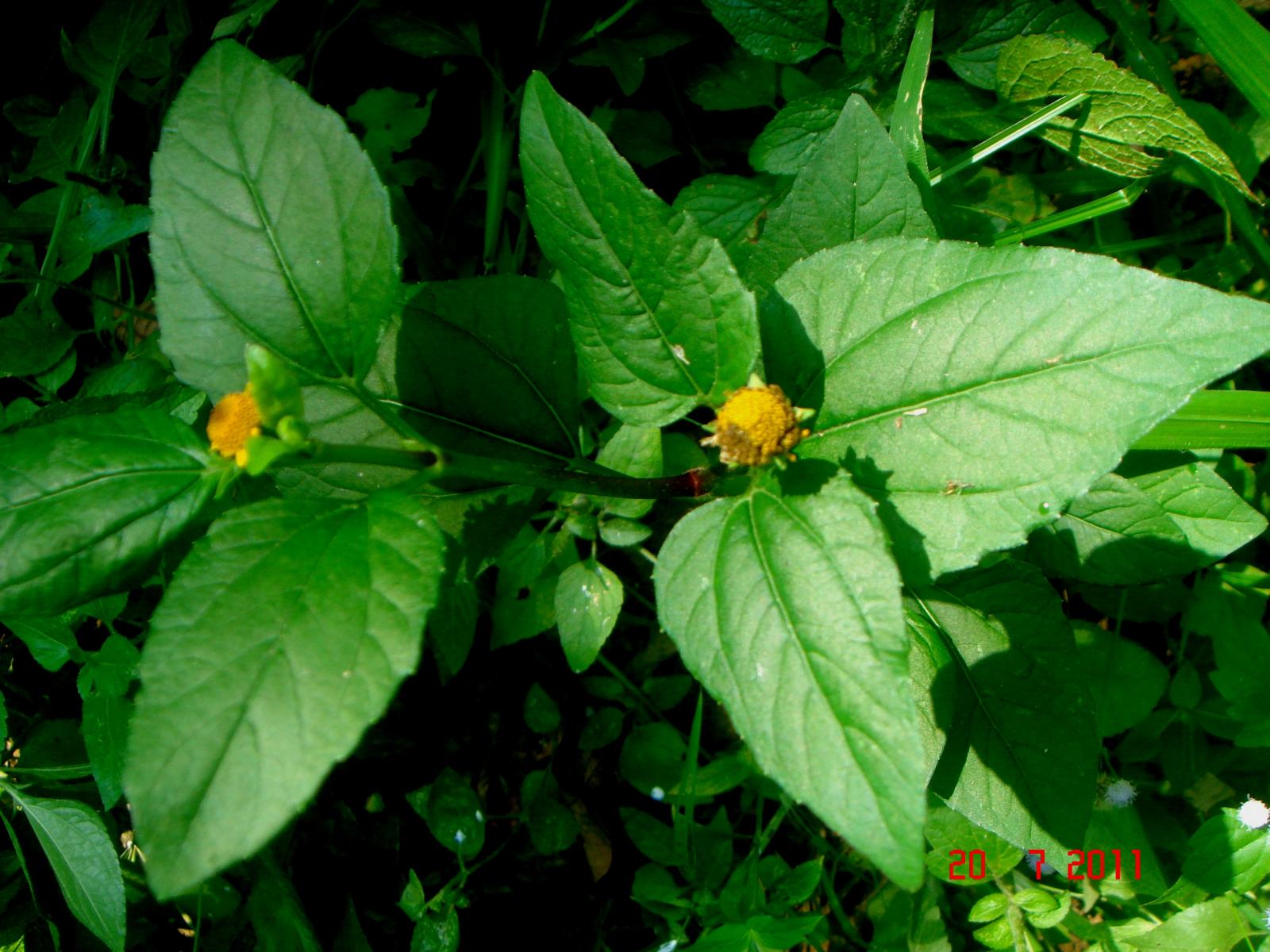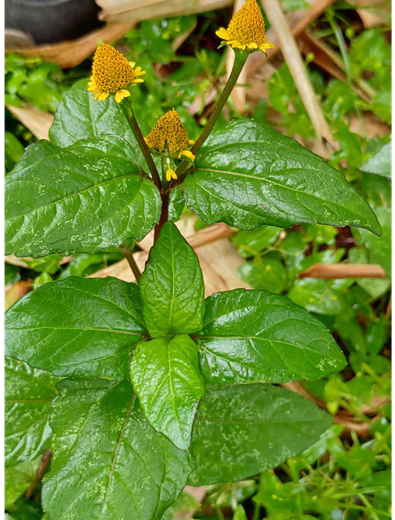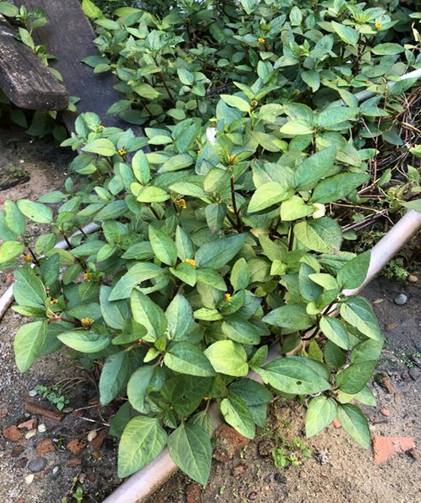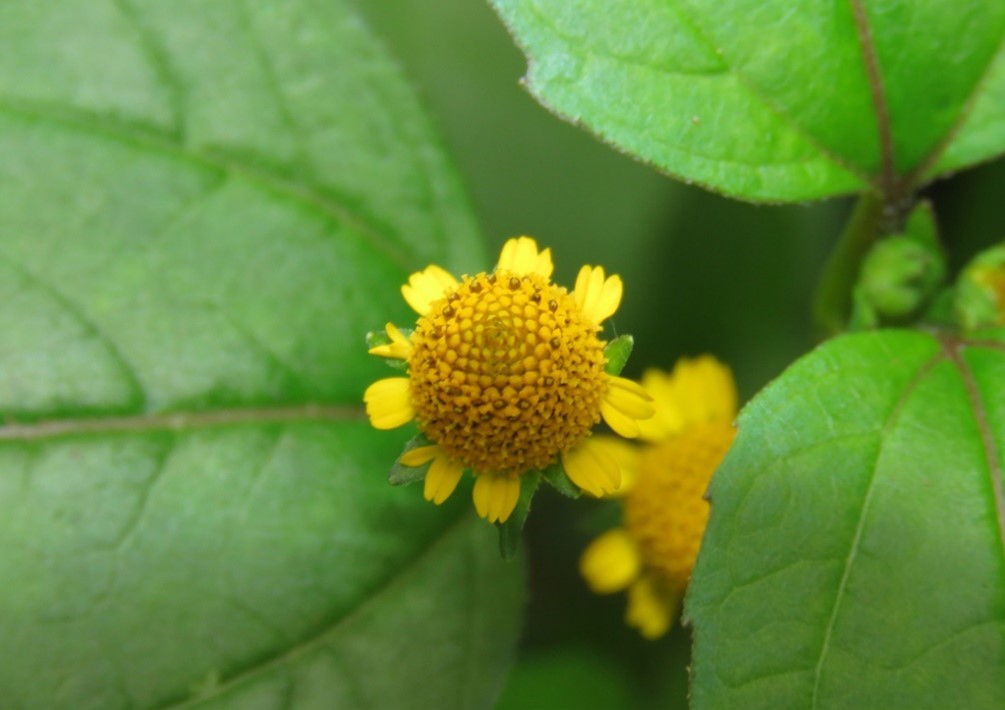ເລກລຳດັບທີ: 764
ລະດັບການຮວບຮວມຂໍ້ມູນ: ເກີອບສົມບູນ
ປັບປູງຄັ້ງລ່າສຸດ: 2025-02-11
ຜັກຄາດ
Toothache plant
Acmella oleracea (L.) R.K. Jansen
ພືດ
ພືດລົ້ມລຸກ
ຜັກ ແລະ ພືດລົ້ມລຸກ
×
ຊື່ທ້ອງຖີ່ນ:
ຜັກຮາດຮື່ນ, ຜັກເຜັດ, ຜັກຂາດຫົວແຫວນ ( Brazilian cress, Para cress, and toothacheplant)
ຊື່ພ້ອງ
:
Acmella calva var. oleracea (Jacq.) Mehrotra, Aswal & B.S.Bisht
Acmella occidentalis (Willd.) Rich. ex Pers.
Acmella oleraceae (L.) R.K.Jansen
Anacyclus pyrethraria (L.) Spreng.
Bidens acmelloides Bergius
Bidens fervida Lam.
Bidens fixa Hook.fil.
Bidens fusca Lam.
Bidens oleracea (L.) Cav.
Bidens oleracea (L.) Cav. ex Steud.
Ceratocephalus acmella subsp. acmella
Cotula dichotoma Pers.
Cotula pyretharia L.
Cotula pyrethraria L.
Isocarpha pyrethraria (L.) Cass.
Pyrethraria dichotoma Pers.
Pyrethraria dichotoma Pers. ex Steud.
Pyrethrum spilanthus Medik.
Spilanthes acmella subsp. oleracea (L.) C.B.Clarke
Spilanthes acmella subsp. oleracea (L.) C.B.Clarke ex Hook.f.
Spilanthes acmella var. oleracea (L.) Baker, 1884
Spilanthes acmella var. oleracea (L.) C.B.Clarke
Spilanthes acmella var. oleracea (L.) C.B.Clarke ex Hook.fil.
Spilanthes calva var. oleracea (Jacq.) Mehrotra, Aswal & B.S.Bisht
Spilanthes fusca Lam.
Spilanthes oleracea Jacq.
Spilanthes oleracea L.
Spilanthes oleracea subsp. fusca (Lam.) DC.
Spilanthes oleracea subsp. oleracea
Spilanthes oleracea var. fusca (Lam.) DC.
Spilanthes oleracea var. oleracea
Spilanthes radicans Schrad. ex DC.
Acmella occidentalis (Willd.) Rich. ex Pers.
Acmella oleraceae (L.) R.K.Jansen
Anacyclus pyrethraria (L.) Spreng.
Bidens acmelloides Bergius
Bidens fervida Lam.
Bidens fixa Hook.fil.
Bidens fusca Lam.
Bidens oleracea (L.) Cav.
Bidens oleracea (L.) Cav. ex Steud.
Ceratocephalus acmella subsp. acmella
Cotula dichotoma Pers.
Cotula pyretharia L.
Cotula pyrethraria L.
Isocarpha pyrethraria (L.) Cass.
Pyrethraria dichotoma Pers.
Pyrethraria dichotoma Pers. ex Steud.
Pyrethrum spilanthus Medik.
Spilanthes acmella subsp. oleracea (L.) C.B.Clarke
Spilanthes acmella subsp. oleracea (L.) C.B.Clarke ex Hook.f.
Spilanthes acmella var. oleracea (L.) Baker, 1884
Spilanthes acmella var. oleracea (L.) C.B.Clarke
Spilanthes acmella var. oleracea (L.) C.B.Clarke ex Hook.fil.
Spilanthes calva var. oleracea (Jacq.) Mehrotra, Aswal & B.S.Bisht
Spilanthes fusca Lam.
Spilanthes oleracea Jacq.
Spilanthes oleracea L.
Spilanthes oleracea subsp. fusca (Lam.) DC.
Spilanthes oleracea subsp. oleracea
Spilanthes oleracea var. fusca (Lam.) DC.
Spilanthes oleracea var. oleracea
Spilanthes radicans Schrad. ex DC.
ຊື່ສະກຸນ:
Asteraceae
ຊະນິດໃກ້ຄຽງ:
ຫ້ອມແກ່ວ/ White Head
ກະດຸມເຄືອ/ Climbing wedelia
ກະດຸມເຄືອ/ Climbing wedelia
ບັນຍາຍລັກສະນະທາງພືດສາດ:
ພືດຊະນິດຈັດເປັນພືດລົ້ມລຸກອາຍຸຫຼາຍປີ ທີ່ສາມາດເຕີບໂຕໄດ້ສູງຮອດ 90 ຊມ.ມີລຳຕົ້ນທີ່ແຜ່ຂະຫຍາຍໄປຕາມພື້ນດິນ ເຮັດໃຫ້ມີລັກສະນະແຜ່ກວ້າງ.
ກ້ານໃບຍາວ 2 ຫາ 6 ຊມ., ໃບກວ້າງ ແລະ ອາດເປັນຮູບໄຂ່ ຫຼື ຮູບສາມຫຼ່ຽມ, ໂດຍຈະຍາວຢູ່ລະຫວ່າງ 5 ຫາ 10. 5 ຊມ. ກວ້າງ 4 ຫາ 8 ຊມ. ຂອບແສກແຂ້ວເລີ່ອຍ, ໂຄນໃບເວົ້າ, ປາຍສັ້ນ ຫຼື ແຫຼມ.
ກ້ານຊໍ່ດອກຍາວ 3.5 ຫາ 12.5 ຊມ., ຊໍ່ດອກແບບກະຈຸກ, ຮູບກົມມົນ ຫຼື ຮູບຊົງກະບອກ, ສູງ 10.5 ຫາ 23.5 ມມ., ເສັ້ນຜ່າສູນກາງ 11 ຫາ 17 ມມ. ໃບປະດັບ (ໂຄ້ງສ້າງຄ້າຍໃບທີ່ຊ່ວຍພະຍຸງດອກ) ຮຽງເປັນສາມຊັ້ນ, ຊັ້ນນອກເປັນຮູບຮີແຄບ 5 ຫາ 6 ໃບ, ຍາວ 5.8 ຫາ 7.3 ມມ., ແລະ ກວ້າງ 2.1 ຫາ 2.8 ມມ. ດອກສົມບູນເພດ, ມີລັກສະເດັ່ນຄືມີກີບດອກສີເຫຼືອງຈຳນວນຫຼາຍ ຮຽງເປັນ 5 ແຖວ, ແຕ່ລະແຖວຍາວ 2.7 ຫາ 3.3 ມມ., ຫຼອດຂ້ອນຂ້າງສັ້ນ 0,5 ຫາ 0.7 ມມ.
ໝາກມີຂະໜາດນ້ອຍ ໂດຍມີຄວາມຍາວ 2 ຫາ 2.5 ມມ.
ແຫຼ່ງທີ່ມາ: [1]
ພືດຊະນິດນີ້ເປັນພືດລົ້ມລຸກ ລຳຕົ້ນສາມາດຕັ້ງຂື້ນ ຫຼື ເລືອແຜ່ຂະຫຍາຍໄປຕາມພື້ນດິນ, ຕົ້ນເປັນສີຂຽວ ຫາ ສີແດງ, ໂດຍທົ່ວໄປບໍ່ມີຂົນ, ໝາຍຄວາມວ່າລຳຕົ້ນລຽບ.
ກ້ານໃບຍາວ 2 ຫາ 6.4 ຊມ., ແລະ ລຽບ ຫຼື ມີຂົນເລັກບາງໆ, ແຜ່ນໃບຮູບໄຂ່ກວ້າງ ຫຼື ຮູບສາມຫຼ່ຽມ, ໂດຍມີຄວາມຍາວ 5 ຫາ 10 ຊມ., ແລະ ກວ້າງ 4 ຫາ 8 ຊມ., ໃບລຽບທັງສອງຂ້າງ, ໂຄນໃບຕັດ ຫຼື ຮຽວແຫຼມ, ຂອບແສກແຂ້ວຍເລືອຍ, ປາຍໃບແຫຼມ ຫຼື ແຫຼມຄົມ.
ດອກອອກເປັນຊໍ່ຮູບຈານ, ສູງ 10.5 ຫາ 23,5 ມມ., ແລະ ມີເສັ້ນຜ່າສູນກາງ 11 ຫາ 17 ມມ. ກ້ານຊໍ່ດອກມີຄວາມຍາວ 3,5 ຫາ 12,5 ຊມ., ລຍບ ຫຼື ມີຂົນບາງໆ. ຊໍ່ດອກປະກອບດ້ວຍໃບປະດັບ 15 ຫາ 18 ໃບ, ຮຽງເປັນ 3 ຊັ້ນ, ຊັ້ນນອກມີ 5 ຫາ 6 ໃບ, ມີລັກສະນະແຄບ ແລະ ເປັນຮູບຮີ, ຍາວ 5.8 ຫາ 7,3 ມມ., ແລະ ກວ້າງ 2,1 ຫາ 2,8 ມມ., ຮູບໄຂ່ແຄບ ຫຼື ຮູບຫອກ, ປາຍແຫຼມ. ພາຍໃນຊໍ່ດອກມີດອກຍ່ອຍ 400 ຫາ 600 ດອກ, ແຕ່ລະດອກຈະມີກີບດອກສີເຫຼືອງ, ແຍກອອເປັນ 5 ແສກ, ຍາວ 2,7 ຫາ 3,3 ມມ. ຫຼອດດອກສັ້ນ, ຍາວ 0,5 ຫາ 0,6 ມມ., ແລະ ກວ້າງ 0,2 ຫາ 0,4 ມມ. ເກສອນຜູ້, ຍາວ 1,4 ຫາ 1,7 ມມ.
ໝາກເປັນສີດຳ, ຍາວ 2 ຫາ 2,5 ມມ. ກວ້າງ 0,9 ຫາ 1,1 ມມ. ມີຂົນອ່ອນນຸ້ມຈັບປານກາງ ຫາ ໜາແໜ້ນ.
ແຫຼ່ງທີ່ມາ: [7]
ກ້ານໃບຍາວ 2 ຫາ 6 ຊມ., ໃບກວ້າງ ແລະ ອາດເປັນຮູບໄຂ່ ຫຼື ຮູບສາມຫຼ່ຽມ, ໂດຍຈະຍາວຢູ່ລະຫວ່າງ 5 ຫາ 10. 5 ຊມ. ກວ້າງ 4 ຫາ 8 ຊມ. ຂອບແສກແຂ້ວເລີ່ອຍ, ໂຄນໃບເວົ້າ, ປາຍສັ້ນ ຫຼື ແຫຼມ.
ກ້ານຊໍ່ດອກຍາວ 3.5 ຫາ 12.5 ຊມ., ຊໍ່ດອກແບບກະຈຸກ, ຮູບກົມມົນ ຫຼື ຮູບຊົງກະບອກ, ສູງ 10.5 ຫາ 23.5 ມມ., ເສັ້ນຜ່າສູນກາງ 11 ຫາ 17 ມມ. ໃບປະດັບ (ໂຄ້ງສ້າງຄ້າຍໃບທີ່ຊ່ວຍພະຍຸງດອກ) ຮຽງເປັນສາມຊັ້ນ, ຊັ້ນນອກເປັນຮູບຮີແຄບ 5 ຫາ 6 ໃບ, ຍາວ 5.8 ຫາ 7.3 ມມ., ແລະ ກວ້າງ 2.1 ຫາ 2.8 ມມ. ດອກສົມບູນເພດ, ມີລັກສະເດັ່ນຄືມີກີບດອກສີເຫຼືອງຈຳນວນຫຼາຍ ຮຽງເປັນ 5 ແຖວ, ແຕ່ລະແຖວຍາວ 2.7 ຫາ 3.3 ມມ., ຫຼອດຂ້ອນຂ້າງສັ້ນ 0,5 ຫາ 0.7 ມມ.
ໝາກມີຂະໜາດນ້ອຍ ໂດຍມີຄວາມຍາວ 2 ຫາ 2.5 ມມ.
ແຫຼ່ງທີ່ມາ: [1]
ພືດຊະນິດນີ້ເປັນພືດລົ້ມລຸກ ລຳຕົ້ນສາມາດຕັ້ງຂື້ນ ຫຼື ເລືອແຜ່ຂະຫຍາຍໄປຕາມພື້ນດິນ, ຕົ້ນເປັນສີຂຽວ ຫາ ສີແດງ, ໂດຍທົ່ວໄປບໍ່ມີຂົນ, ໝາຍຄວາມວ່າລຳຕົ້ນລຽບ.
ກ້ານໃບຍາວ 2 ຫາ 6.4 ຊມ., ແລະ ລຽບ ຫຼື ມີຂົນເລັກບາງໆ, ແຜ່ນໃບຮູບໄຂ່ກວ້າງ ຫຼື ຮູບສາມຫຼ່ຽມ, ໂດຍມີຄວາມຍາວ 5 ຫາ 10 ຊມ., ແລະ ກວ້າງ 4 ຫາ 8 ຊມ., ໃບລຽບທັງສອງຂ້າງ, ໂຄນໃບຕັດ ຫຼື ຮຽວແຫຼມ, ຂອບແສກແຂ້ວຍເລືອຍ, ປາຍໃບແຫຼມ ຫຼື ແຫຼມຄົມ.
ດອກອອກເປັນຊໍ່ຮູບຈານ, ສູງ 10.5 ຫາ 23,5 ມມ., ແລະ ມີເສັ້ນຜ່າສູນກາງ 11 ຫາ 17 ມມ. ກ້ານຊໍ່ດອກມີຄວາມຍາວ 3,5 ຫາ 12,5 ຊມ., ລຍບ ຫຼື ມີຂົນບາງໆ. ຊໍ່ດອກປະກອບດ້ວຍໃບປະດັບ 15 ຫາ 18 ໃບ, ຮຽງເປັນ 3 ຊັ້ນ, ຊັ້ນນອກມີ 5 ຫາ 6 ໃບ, ມີລັກສະນະແຄບ ແລະ ເປັນຮູບຮີ, ຍາວ 5.8 ຫາ 7,3 ມມ., ແລະ ກວ້າງ 2,1 ຫາ 2,8 ມມ., ຮູບໄຂ່ແຄບ ຫຼື ຮູບຫອກ, ປາຍແຫຼມ. ພາຍໃນຊໍ່ດອກມີດອກຍ່ອຍ 400 ຫາ 600 ດອກ, ແຕ່ລະດອກຈະມີກີບດອກສີເຫຼືອງ, ແຍກອອເປັນ 5 ແສກ, ຍາວ 2,7 ຫາ 3,3 ມມ. ຫຼອດດອກສັ້ນ, ຍາວ 0,5 ຫາ 0,6 ມມ., ແລະ ກວ້າງ 0,2 ຫາ 0,4 ມມ. ເກສອນຜູ້, ຍາວ 1,4 ຫາ 1,7 ມມ.
ໝາກເປັນສີດຳ, ຍາວ 2 ຫາ 2,5 ມມ. ກວ້າງ 0,9 ຫາ 1,1 ມມ. ມີຂົນອ່ອນນຸ້ມຈັບປານກາງ ຫາ ໜາແໜ້ນ.
ແຫຼ່ງທີ່ມາ: [7]
ນິເວດວິທະຍາ
ເຂດກະຈາຍພັນທົ່ວໂລກ:
Native to Brazil Southeast. [6]
ຊະນິດພັນພື້ນໃນຕາເວັນອອກສ່ຽງໃຕ້ຂອງບາຊິວ. [6]
Global distribution between 2004 to 2024. Source: [2]
ເຂດກະຈາຍພັນທົ່ວໂລກໃນລະຫວ່າງປີ 2004 ຫາ 2024. ແຫຼ່ງທີ່ມາ: [2]
ຊະນິດພັນພື້ນໃນຕາເວັນອອກສ່ຽງໃຕ້ຂອງບາຊິວ. [6]
Global distribution between 2004 to 2024. Source: [2]
ເຂດກະຈາຍພັນທົ່ວໂລກໃນລະຫວ່າງປີ 2004 ຫາ 2024. ແຫຼ່ງທີ່ມາ: [2]
ເຂດກະຈາຍພັນໃນລາວ
:
ລຽບແມ່ນ້ຳຂອງພາກເໜືອ
ເຂດລຽບແມ່ນ້ຳຂອງພາກໃຕ້
ເຂດລຽບແມ່ນ້ຳຂອງພາກໃຕ້

ເຂດກະຈາຍພັນຕາມພູມສັນຖານ
:
ແຄມຝັ່ງນໍ້າ
ເຂດຜະລິດພືດຜົນເນີນສູງ
ເຂດຊຸມຊົນ
ເຂດຜະລິດພືດຜົນເນີນສູງ
ເຂດຊຸມຊົນ
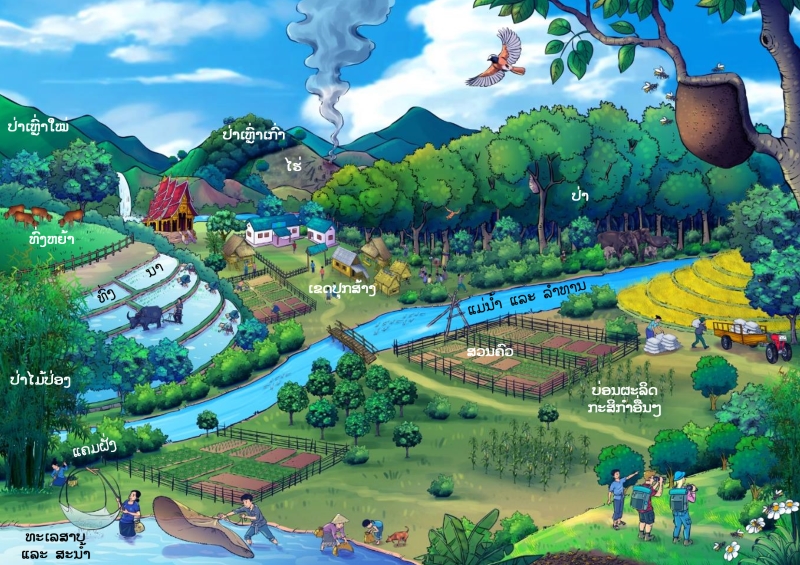
ສະເພາະຖິ່ນໃນລາວ:
ຕ່າງຖິ່ນ
ຮຸກຮານ
:
ບໍ່ຮຸກຮານ
ສະຖານະພາບການອະນູຮັກ IUCN
:
ບໍ່ມີຄວາມສ່ຽງ
ສະຖານະພາບການອະນຸຮັກແຫ່ງຊາດລາວ
:
ບໍ່ຖືກລະບຸໃນບັນຊີປະເພດໃດ
ການນຳໃຊ້
ປະເພດການນຳໃຊ້:
ກິດຈະກຳການກະເສດ
ອາຫານ
ພືດເປັນຢາ
ອາຫານ
ພືດເປັນຢາ
ບັນຍາຍການນຳໃຊ້:
ອາຫານ: ຍອດ ແລະ ໃບອ່ອນ ເປັນສ່ວນປະສົມທີ່ມີປະໂຫຍດຫຼາຍ ສາມາດນຳມາໃຊ້ໃນການປຸ່ງອາຫານໄດ້ຫຼາກຫຼາຍເມນູ ເປັນຕົ້ນແມ່ນນຳມາຕົ້ມກິນກັບແຈ່ວ, ເປັນສ່ວນປະສົມໃນແກງ ຫຼື ປະສົມໃນຊຸບຜັກ ແລະ ໃຊ້ປຸ່ງແຕ່ງອືນໆ. [4], [5]
ສະໝຸນໄພ: ໃບ ແລະ ດອກນຳມາຕົ້ມເພື່ອໃຊ້ເປັນສະໝຸນໄພພື້ນບ້ານມາເປັນເວລາດົນ ໂດຍໃຊ້ເປັນຢາຮັກສາກາການເຈັບແຂ້ວ, ພະຍາດປາກອັກເສບ, ອາການທ້ອງຜູກ, ແຜໃນກະເພາະອາຫານ ແລະ ຝີໃນຕັບ. ສານສະກັດຈາກຜັກຄາດຂື້ນຊື່ໃນຄຸນສົມບັດທີ່ຫຼາກຫຼາຍ ເຊັ່ນ ຕ້ານເຊື້ອເບັກທິເຣຍ, ຕ້ານເຊື້ອຣາ, ແກ້ປວດ, ຕ້ານຮອຍຫຽວຍົ້ນ, ຕ້ານອານຸມູນອິດສະຫຼະ, ໃຊ້ເປັນຢາປຸກອາລົມທາງເພດສຳຫຼັບຜູ້ຍິງ ແລະ ອອກລິດຕ້ານຄວາມອວ້ນ ເປັນຕົ້ນ. [4]
ກິດຈະກຳທາງການກະເສດ: ໃຊ້ເປັນຢາຂ້າແມງໄມ້ ເຊິ່ງໄດ້ຮັບການພິດສູດແລ້ວວ່າໄດ້ຮັບປະສິດທິພາບຕໍ່ຍຸງ ແລະ ໜອນເຈາະຝັກສາລີ ແລະ ໝາກກໍ່ສາມາດໃຊ້ຂ້າແມງໄມ້ໄດ້ຄືກັນ. [4]
ສະໝຸນໄພ: ໃບ ແລະ ດອກນຳມາຕົ້ມເພື່ອໃຊ້ເປັນສະໝຸນໄພພື້ນບ້ານມາເປັນເວລາດົນ ໂດຍໃຊ້ເປັນຢາຮັກສາກາການເຈັບແຂ້ວ, ພະຍາດປາກອັກເສບ, ອາການທ້ອງຜູກ, ແຜໃນກະເພາະອາຫານ ແລະ ຝີໃນຕັບ. ສານສະກັດຈາກຜັກຄາດຂື້ນຊື່ໃນຄຸນສົມບັດທີ່ຫຼາກຫຼາຍ ເຊັ່ນ ຕ້ານເຊື້ອເບັກທິເຣຍ, ຕ້ານເຊື້ອຣາ, ແກ້ປວດ, ຕ້ານຮອຍຫຽວຍົ້ນ, ຕ້ານອານຸມູນອິດສະຫຼະ, ໃຊ້ເປັນຢາປຸກອາລົມທາງເພດສຳຫຼັບຜູ້ຍິງ ແລະ ອອກລິດຕ້ານຄວາມອວ້ນ ເປັນຕົ້ນ. [4]
ກິດຈະກຳທາງການກະເສດ: ໃຊ້ເປັນຢາຂ້າແມງໄມ້ ເຊິ່ງໄດ້ຮັບການພິດສູດແລ້ວວ່າໄດ້ຮັບປະສິດທິພາບຕໍ່ຍຸງ ແລະ ໜອນເຈາະຝັກສາລີ ແລະ ໝາກກໍ່ສາມາດໃຊ້ຂ້າແມງໄມ້ໄດ້ຄືກັນ. [4]
ການປູກ ການລ້ຽງ:
ຊະນິດທຳມະຊາດ
ລະດູການເກັບກູ້:
ມິຖຸນາ
ກໍລະກົດ
ສິງຫາ
ກໍລະກົດ
ສິງຫາ
ການຕະຫຼາດ ແລະ ຕ່ອງໂສ້ມູນຄ່າ:
N/A
ການຄຸ້ມຄອງຈັດການ
ໄພຄຸກຄາມ: ເນື່ອງຈາກຜັກຄາກເປັນພືດທີ່ສາມາດປູກໄດ້ ແລະ ຈະເລີນເຕີບໂຕຕາມທຳມະຊາດໃນບາງສ່ວນ ຈຶ່ງບໍ່ຖືກຈັດວ່າເປັນພືດທີ່ມີຄວາມສ່ຽງ.
ໂພຊະນາການ
ຄຸນຄ່າທາງໂພຊະນາການ:
ບັນຍາຍຄຸນຄ່າທາງໂພຊະນາການ:
N/A
| ສານອາຫານ | /100g | ໝາຍເຫດ |
|---|---|---|
| ໂປຣຕີນ | N/A | N/A |
| ຄາໂບໄຮເດຣດ | N/A | N/A |
| ໄຂມັນ | N/A | N/A |
| ວິຕາມິນ | N/A | N/A |
| ແຮ່ທາດ | N/A | N/A |
| ເສັ້ນໄຍ | N/A | N/A |
ອ້າງອິງ
ເຄດິດຮູບພາບ:
Leave and Inflorescence. [1] iNaturalist [Online]. Uploaded on 18 November 2023 by: mira_hlt. Available: www.inaturalist.org/photos/336272288. [Accessed: 27 September 2024].
stem of Acmella oleracea. [2] iNaturalist [Online]. Uploaded on 15 February 2024 by: Hellen An-tunes. Available: https://www.inaturalist.org/observations/199333289. [Accessed: 21 January 2025].
Inflorescence and Flower. [3] iNaturalist [Online]. Uploaded on 12 March 2022 by: Célio Moura Ne-to. Available: https://www.inaturalist.org/observations/108381876. [Accessed: 21 January 2025].
stem of Acmella oleracea. [2] iNaturalist [Online]. Uploaded on 15 February 2024 by: Hellen An-tunes. Available: https://www.inaturalist.org/observations/199333289. [Accessed: 21 January 2025].
Inflorescence and Flower. [3] iNaturalist [Online]. Uploaded on 12 March 2022 by: Célio Moura Ne-to. Available: https://www.inaturalist.org/observations/108381876. [Accessed: 21 January 2025].
ອ້າງອິງ:
[1] K.-F. Chung and et al., "Notes on Acmella (Asteraceae: Heliantheae) in Taiwan," Botanical Studies, pp. 73-82, 2008.
[2] Global Biodiversity Information Facility (GBIF), “Acmella oleracea (L.) R.K.Jansen” [Online]. Available: https://www.gbif.org/species/5386764. [Accessed: 27 September 2024].
[3] IUCN Red List of Threatened Species, “Acmella oleracea (L.) R.K.Jansen,” [Online]. Available: https://www.iucnredlist.org/search?query=Acmella%20oleracea%20(L.)%20R.K.Jansen&searchType=species. [Accessed: 27 Sep-tember 2024].
[4] T. Uthpala and S. Navaratne, "Acmella oleracea Plant; Identification, Applications and Use as an Emerging Food Source – Review," Food Reviews International, vol. 10, no. 2, pp. 150-160, 2020.
[5] Useful Tropical Plants, "Acmella oleracea," 2024. [Online]. Available: https://tropical.theferns.info/viewtropical.php?id=Acmella+oleracea. [Accessed: Oct. 18, 2024].
[6] "Acmella oleracea (L.) R.K.Jansen," Kew Science, 2024. [Online]. Available: https://powo.science.kew.org/taxon/urn:lsid:ipni.org:names:914778-1. [Accessed: Jan. 21, 2025].
[7] "Taxon Page for Flora of China," eFloras, 2024. [Online]. Available: http://www.efloras.org/florataxon.aspx?flora_id=2&taxon_id=242412042. [Accessed: Jan. 21, 2025].
[2] Global Biodiversity Information Facility (GBIF), “Acmella oleracea (L.) R.K.Jansen” [Online]. Available: https://www.gbif.org/species/5386764. [Accessed: 27 September 2024].
[3] IUCN Red List of Threatened Species, “Acmella oleracea (L.) R.K.Jansen,” [Online]. Available: https://www.iucnredlist.org/search?query=Acmella%20oleracea%20(L.)%20R.K.Jansen&searchType=species. [Accessed: 27 Sep-tember 2024].
[4] T. Uthpala and S. Navaratne, "Acmella oleracea Plant; Identification, Applications and Use as an Emerging Food Source – Review," Food Reviews International, vol. 10, no. 2, pp. 150-160, 2020.
[5] Useful Tropical Plants, "Acmella oleracea," 2024. [Online]. Available: https://tropical.theferns.info/viewtropical.php?id=Acmella+oleracea. [Accessed: Oct. 18, 2024].
[6] "Acmella oleracea (L.) R.K.Jansen," Kew Science, 2024. [Online]. Available: https://powo.science.kew.org/taxon/urn:lsid:ipni.org:names:914778-1. [Accessed: Jan. 21, 2025].
[7] "Taxon Page for Flora of China," eFloras, 2024. [Online]. Available: http://www.efloras.org/florataxon.aspx?flora_id=2&taxon_id=242412042. [Accessed: Jan. 21, 2025].
ຜູ້ສ້າງ Factsheet:
ຜູ້ກວດສອບ Factsheet:
,
